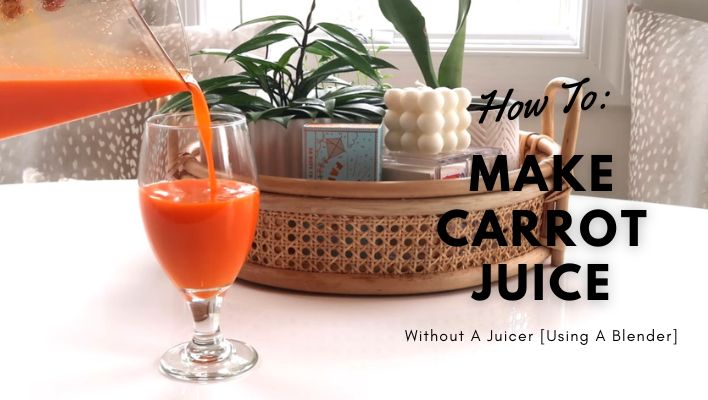Are you interested in making carrot juice, but don’t have a juicer? Don’t worry, it’s actually very easy to make carrot juice without a juicer – you just need a blender or you can even do it using a grater! Making carrot juice without a juicer is a great way to get all of the benefits of carrot juice without having to invest in a juicer. Plus, it’s super easy to do.
We’ll cover how to make carrot juice without a juicer step by step in this post, along with the health advantages of carrots and other crucial information, so you may rapidly get your recommended daily intake of beta-carotene, a vital antioxidant.
Read Also: What is the best Juicer for Carrots?
Carrot Juice Benefits: Why Should I Drink It?
Carrot juice is a great way to improve your health. Beta-carotene, which the body transforms into Vitamin A, is abundant in carrots. In addition to maintaining a healthy immune system, vitamin A is crucial for vision. A large amount of Vitamin C, which is crucial for the health of the skin, hair, and nails, is also present in carrot juice. Carrots also include a lot of fiber, which can aid in regulating digestion.
Nutritional Fact:
According to the Food Data Central (FDC) of the USDA, a cup (236g) of carrot juice has the following amounts of various ingredients:
| Components | Amount |
| Water | 210 grams (89% Of Total Volume) |
| Calories | 94 kcal/389 KJ |
| Protein | 2.24 grams |
| Total Lipid (Fat) | 0.35 grams |
| Carbohydrate | 22 grams |
| Sugars | 9 grams |
| Fiber | 2 grams |
| Vitamin A (as a provitamin) | 2260 µg (251% of the Daily Value) |
| Vitamin C | 20 mg (22% of the Daily Value) |
| Vitamin K | 36 µg (31% of the Daily Value) |
| Vitamin E (alpha-tocopherol) | 1.16 mg (8% of the Daily Value) |
| Potassium | 689 mg (15% of the Daily Value) |
| Calcium | 56.6 mg (4.5% of the Daily Value) |
| Sodium | 156 mg (7% of the Daily Value) |
| Beta Carotene | 21900 µg |
Besides the above, carrot juice also contains Lycopene, Lutein, Zeaxanthin, Thiamin, Riboflavin, Folate, and more essential components for our body.
Health Benefits Of Carrot Juice:
Carrot juice is an excellent source of vitamins and minerals, which helps you to get the following health benefits if you consume carrot juice on a regular basis.
Improve Eye Health: It aids in enhancing eye health. 236 grams of carrot juice includes 2260 micrograms of provitamin or carotenoid vitamin A in them. Vitamin A is essential for lowering the risk of blindness and age-related eye disorders like macular degeneration (AMD)(*1).
Enhance Skin Health: Juice from carrots helps to even out skin tone. A cup of carrot juice has 20 milligrams of vitamin C which is 22% of the recommended daily dose. This water soluble vitamin C aids in the synthesis of collagen, which improves skin strength and elasticity and shields your hair from free radical damage(*2).
Boost Immunity: Carrot juice contains vitamins A and C, which function as antioxidants and help to enhance your immune system(*3). It also contains a significant amount of vitamin B6, which prevents the deterioration of our immunological cells(*4).
Improve Heart Health: Antioxidants and Potassium present in carrot juice help to protect against high blood pressure and stroke.
Anti-Carcinogenic Properties: Polyacetylenes, beta carotene, and lutein which are found in carrot juice have anti-carcinogenic properties that help protect against the growth of cancer cells(*5).
Protect Liver: Carrot juice’s carotenoids have anti-inflammatory and antioxidant effects that aid to promote liver function, specifically against nonalcoholic fatty liver disease (NAFLD).
Source Of Energy: Carrot juice has 94 kcal of energy per cup. As a result, carrot juice not only feeds you important nutrients but also provides good energy and keeps you hydrated.
Carrot juice is generally a beneficial beverage, with a few drawbacks. So, everyone should drink a glass of carrot juice every day to enhance their immune system and keep diseases at bay.
Read Also: How To Get Protein While Juicing?
Ingredients For Carrot Juice
- Carrots (As per your taste)
- Water
- Fresh Ginger
- Fresh Lemon
Necessary Kitchen Utensils
- Blender/Greater
- Cheesecloth/Nut milk bag
- Pitcher, and
- Mason Jar
Variations: What Other Flavors Can I Add?
For flavor variations, you can also mix in cucumber, apple, celery, orange, or pineapple juice with your carrot juice. By experimenting with various flavors, you can stop drinking the same juice every day. We’ll share various carrot juice recipes below so you may sample fresh and delicious carrot juice with new flavors every time.
How To Choose Carrots For Juicing
There are a few things to consider when choosing the best carrots for juicing. First, you’ll want to make sure they’re fresh – look for carrots that are bright in color and have firm, crisp flesh. Second, you’ll want to choose carrots that of similar in size so that they juice evenly. And finally, you’ll want to avoid carrots with any blemishes or damage, as these, can affect the quality of your juice.
Many types of carrots can be juiced, but the best carrots for juicing are those high in sugar and water content. These carrots are typically the sweeter varieties, such as the Nantes, Danvers, and Chantenay carrots. They are also the juiciest, so they will yield more juice than other types of carrots.
With these factors in mind, head to your local grocery store or farmer’s market and choose the freshest, most perfect carrots you can find. Your juicer will thank you!

Tips For Making Carrot Juice
- You can chill the carrots in the fridge for one hour before juicing to enjoy cool juice or may use chilled water during blending.
- Avoid refrigerating carrots with other fruits like bananas or pears to protect them from ethylene gas.
- After a while, the carrot juice separates. Before serving, simply whisk it with a spoon.
- Feel free to experiment by including ginger, honey, or any other sweetener and fresh turmeric, apple, or basil as add-ins of your preference.
- Fresh carrots can generate the most juice. Choose carrots with smooth shapes, vibrant colors, and green leaves if you want to buy fresh, newly harvested carrots.
- Choose purple carrots if you want a lot of antioxidants. They are high in antioxidants and anthocyanin and are excellent for making savory flavor juice.
- Scrub carrots instead of peeling to get max nutrients as vitamin C, vitamin B3, and antioxidants are mostly stored under the skin.
Read Also: How To Make Juice Without A Juicer?
How To Juice Carrots Without A Juicer
You can still create carrot juice if you don’t have a juicer, so don’t worry! Carrot juice may be made in a few different ways without a juicer.
One method is to grate the carrots and extract the juice using a cheesecloth or coffee filter afterward.
Another method involves blending the carrots in a blender and then filtering the liquid through cheesecloth or a coffee filter.
Below, we’ll go over both approaches. Keep going with us.
Groundwork For Making Carrot Juice
We must appropriately choose fresh, tender carrots if we want healthful carrot juice. Better carrots come from organic sources, however. Now that you’ve chosen them from the store, it’s time to prepare to make juice.
If you want to keep the carrots you bought for later use, trim the leaves so that there is just about an inch of brunches left with the carrot top, wash them, and put them in a zippered bag in the refrigerator.
Cut the leaves first if you want to produce juice as soon as you acquire them from the shop. Since leaves are exposed to the air, they have a higher concentration of dirt and pesticides than roots. They also have a bitter flavor, which many juicers dislike.
Step 1 Washing
When we make juice, we actually eat carrots in raw condition (without boiling). Therefore, it is important to wash them well whether it is organic or not.
For organic carrots, wash them thoroughly with clean water to remove any dirt on them.
In the case of non-organic carrots, use the scrubber to wash them. If you use a scrubber during washing carrots, you might not need to peel them. Carrots’ skin contains lots of vitamins and antioxidants. So, it is better not to peel the carrots.
Step 2 Cut The Tops Off
Cutting off the carrot top comes after washing. Cut up to the green layer.
There is debate on the suitability of carrot tops for eating and their potential health advantages.
The Guardian claims that carrot tops have numerous health advantages and are full of nutrients, including almost six times as much vitamin C as the root as well as significant amounts of potassium, calcium, and phytonutrients.
Therefore, we can say, carrot tops are edible. However, if you include them in your juice, it could taste acrid. Therefore, it is best to put them aside for composting.
Step 3 Peel Off The Skin
I like to buy organic carrots so I don’t have to peel them before making juice and they are more healthy. If you do choose non-organic carrots, you may still take the skins, but you’ll need to wash them thoroughly.
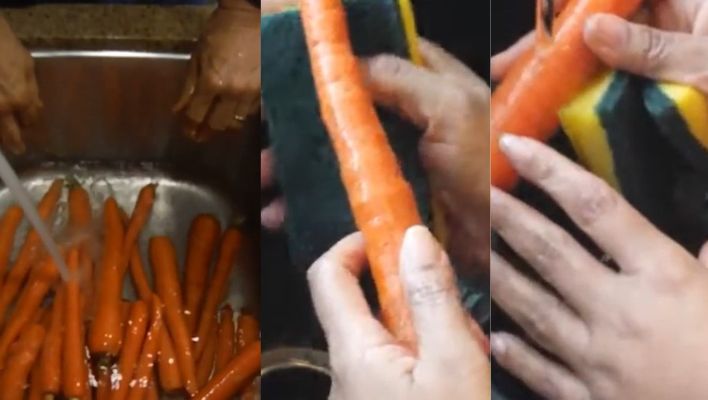
How To Make Carrot Juice Using A Blender
The processes listed above are the same regardless of the method you use to produce carrot juice. Then, you need to take the additional steps below if you wish to utilize a blender.
Step 4 Roughly Chop The Carrots
Chop the washed carrots into small dice about half inches in size. It will help the blender to liquefy the carrots smoothly without jamming.
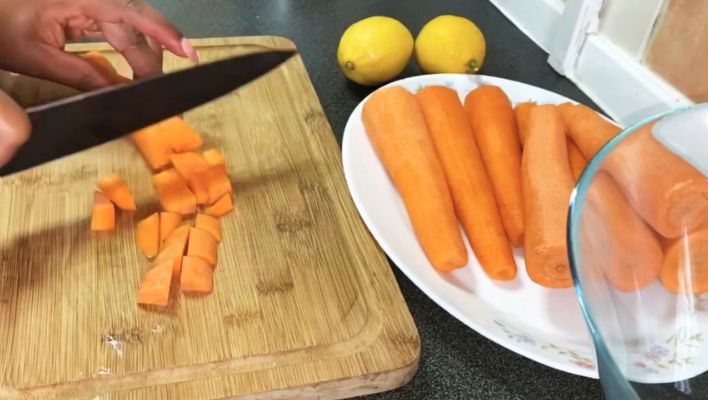
Step 5 Add Chopped Carrots To Blender
Put the chopped carrots into a blender container. Add water to the halfway of chopped carrots and run the blender until all carrots are blended. If required, you may add more water to get a fine texture. The amount of water actually depends on the amount of juice you want.
If you want a bit of chilled juice, you can add cool water at this stage.
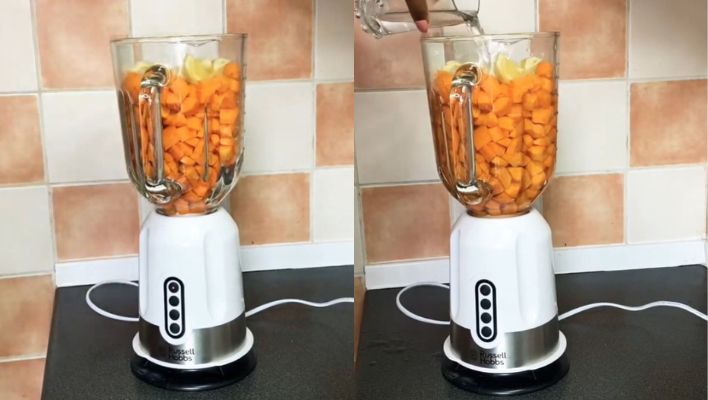
Step 6 Strain It
After blending, take a bowl and pour the smoothies into a cheesecloth or nut milk bag or in a fine mesh sieve (which one is available in your hand). Then press the nut milk bag with your fingers or use a spoon to extract the juice from the smoothies.
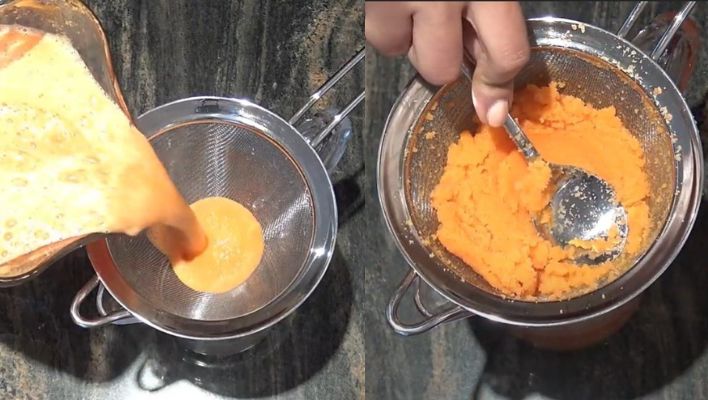
How To Juice Carrots Without A Juicer (By Hand)
If you have no blender or juicer available near you, you can still make carrot juice. It is a bit laborious process, however, nothing can stop you from enjoying delicious carrot juice.
Step 4 Finely Chop The Carrots
Follow steps 1 to 3 for preparing carrots and re-start from this step for the hand juicing method. Instead of roughly chopping, you have to cut the carrots into fine pieces. You can use your cheese grater to do this. The more finely you can chop them, it will be easier to extract the juice.

Step 5 Put Them Into A Pitcher
Take the finely chopped carrots into a bowl or pastel. Mash them with your fingers or past them with pastels so that the water part is easily removed from the pulp.
Step 6 Extract The Juice
Now put the mashed carrots into a nut milk bag or cheesecloth. Extract the juice from the pulp by gently pressing with your fingers.
Read Also: How To Make A Ginger Shots Without A Juicer?
Final Step – Store In A Mason Jar and Enjoy
In a mason jar, pour the juice that was extracted. Now, depending on your preference, you can add some lemon or ginger juice or both to make it more vibrant. That’s it for now. The juice can be consumed immediately or put in the freezer for later use.
Read Also: How To Make Celery Juice Without A Juicer?
Easy And Delicious Carrot Juice Recipes
To bring variation in your carrot juice intake, we are going to share some crips and healthy carrot juice recipes below.
Health Booster -Carrot Apple Celery Juice
Celery is a craze of juicing and has lots of health benefits. When you add celery to your carrots juice, it will be going to be the best healthy juice ever.
What You Will Need
- 4 to 5 medium-sized carrots to get 7 oz juice
- 1 pound apple to get 7 oz of juice
- 2 to 3 Celery stalks to get 1 oz of extract
- 0.25 oz ginger juice
- 1 tbsp sugar or honey
- 2 to 3 Ice cubes
Serving Size: 2 cups (16 oz)
Preparations:
Wash all the ingredients thoroughly with clean water. Scrub the carrots and peel the apple before cut into small pieces. Cut the celery stalks into small pieces too. Peel off the ginger skin.
Put all the ingredients into a blender or a juicer (which one is available to you). Run and liquefy them finely.
If you use a blender, strain the smoothies with a cheesecloth.
Pour the extract into two mason jars, and add honey and ice cubes before drinking. If you want to refrigerate, keep it in an air-tight jar to protect being oxidized.
Read Also: 5 Anti-Inflammatory Juicing Recipes

Stamina Booster – Carrot Apple Beet Juice
Through an increase in blood plasma nitrate levels, beets can help you increase your stamina when exercising. You could receive a complete serving of antioxidants and an immune system booster when you make juice from carrots and beets for your daily workout.
What You Will Need
- 1 lb of beet juice to get about 8 oz of juice
- 15 – 16 medium-sized carrots to get about 16 oz of juice
- 3 -5 medium-sized gala apples to get 10 oz of juice
- 0.25 oz ginger, about ½-inch knob
- 2 tbsp lemon juice
- 2 tbsp honey
Serving Size: 4 cups (32 oz)
Preparations:
Wash all the ingredients thoroughly with clean water. Use a peeler to peel off the skins of beet, apple, and zinger. Scrub the carrots to wash deeply. Chopp all the ingredients will small pieces.
Now put them into a juicer or blender. Run the machine and liquefy smoothly. Strain it if necessary.
Add lemon juice to make the juice more bright and balance the flavor. Add a little honey to make it sweet.
Store it in mason jars or juice glasses and serve it to your family or friends after a little garnishing.
Read Also: 10 Juice Recipes To Start Losing Weight

Summer Delight – Carrot Orange Pineapple Juice
If you’re looking for refreshing juice on a hot summer day, you can give a try to this carrot orange pineapple juice.
What You Will Need
- 9 medium-sized carrots to get 8 oz juice
- 3 and a half navel oranges to get 12 oz juice
- ⅓ pineapple to get 8 oz juice
- 1 tbsp honey
- 1 bunch of fresh mint leaves
- 3 – 4 ice cubes
Serving Size: 4 cups (32 oz)
Preparations:
Wash all the ingredients thoroughly with clean water. Scrub the carrots and cut them into small pieces. Peel the pineapple and cut it into small pieces. Peel off the oranges, and separate the seeds (if any).
Put all the ingredients into a juicer or blender. Run it up to the time of extracting all juice from pulps. If you use a blender, use cheesecloth to strain it.
Pour into a pitcher or glasses. Add honey and ice cubes. Serve with mint leaf on top.
Read Also: 5 Best Juicing Recipes For Energy And Weight Loss
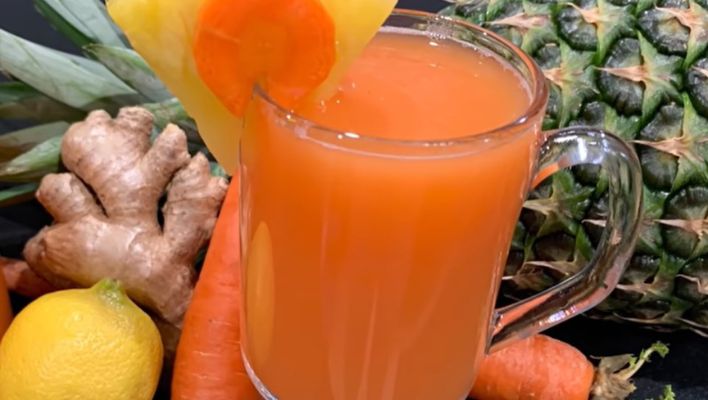
What Can You Do With The Pulp & Carrot Tops?
There is a lot to do with the leftover pulp of carrot juice and its tops. Let’s find some ideas below –
With Pulp
- You may make smoothies using the leftover carrot pulp.
- You can flavor your glass of water by making ice cubes to put in it.
- You may also incorporate carrot pulp into the pancake batter for more taste and texture.
- Add carrot pulp to your baked meal to make it healthier and fruitier.
- If the aforementioned suggestions bore you, you can also create compost with the leftover pulp.
With Tops And Greens
- Spread the carrot tops in a salad after dicing them into small pieces.
- Put them on soups like vegetable soup, carrot ginger soup, butternut soup, and others as garnish.
- They can be added to roasted vegetables as a garnish.
- They should be minced and scattered on a grain bowl, such as the Carrot Ginger Grain Bowl.
- You can use carrot tops to regrow it organically in your backyard garden too.
Read Also: The Best Ways To Use The Leftover Juice Pulp
How To Store Carrot Juice?
It is advised to consume freshly produced fruit juice. However, you can store them in a refrigerator if you find yourself juicing a large amount of carrots at once or want to create juice for later use to save time. Pour the juice into a lidded, airtight mason jar to achieve this. Any fruit juice that has been made has begun to oxidize. Therefore, it must be stored in an airtight container.
In the refrigerator, juice can be kept for 24 to 48 hours. You must keep it frozen if you want to keep it for a longer period of time. Don’t completely fill the jar when storing it in the freezer. Maintain a top expansion gap of at least one centimeter.
Read Also: The Best Ways To Store Juice After Making
Is Carrot Juice Do Any Harm?
Carrot juice has numerous advantages, but it also has some disadvantages. You could develop carotenemia if you consume a lot of carrot juice. It is a condition where excessive blood levels of beta-carotene cause your skin to turn yellow-orange. Additionally, pregnant women, toddlers, and anyone with impaired immune systems should never drink fresh, unpasteurized carrot juice as it may contain harmful bacteria.
FAQs
Can You Blend Raw Carrots In A Blender?
Yes, you can blend raw carrots (without boiling them) in a blender. However, it will be better if you use a strong blender like Vitamix.
Can I Add Sugar To My Carrot Juice?
Carrot varieties like Nantes and Danvers have a sweet flavor by nature. You won’t need sugar if you choose any of these. However, if you want it to be even sweeter, you can add honey. Because honey is better for you than sugar. If you decide to use sugar in your carrot juice, do not use more than 13 grams per 8 oz serving.
Is It Better To Blend Or Juice Carrots?
Carrot fibers are beneficial to our digestive system. Juicers primarily separate the carrot pulps from the liquid portion of the carrots. But when we blend carrots, we typically end up with both liquid and fibers (if we do not strain them). Therefore, blending is preferable to using a juicer if you require juice that is nutritious and beneficial for your gut.
What Happens If I Drink Carrot Juice Every Day?
If you drink too much carrot juice, your skin may turn yellow, and your teeth decaying. If you have a fruit allergy, drinking excessive carrot juice will not good for you too.
Do You Have To Peel Carrots To Juice Them?
Regarding health benefits, it doesn’t matter whether you peel carrots or not. It is true that carrots’ skins are rich in vitamin C, micronutrients, and beta-carotene. However, the phloem (the middle layer) contains the same quantity of those nutrients. Therefore, whether or not to peel your carrots before juicing is a matter of preference.
References:
*1 – Dietary nutrient intake and progression to late age-related macular degeneration in the Age-Related Eye Disease Studies 1 and 2.
Studies By Elvira Agrón, MA, Julie Mares, Ph.D., Traci E. Clemons, Ph.D., Anand Swaroop, Ph.D., Emily Y. Chew, MD, Tiarnan D. L. Keenan, BM BCh, Ph.D., and AREDS and AREDS2 Research Groups
*2 – The Roles of Vitamin C in Skin Health
Juliet M. Pullar, Anitra C. Carr, and Margreet C. M. Vissers
*3 – Role of Vitamin A in the Immune System.
Studies By Zhiyi Huang, Yu Liu, Guangying Qi, David Brand, and Song Guo Zheng
*4 – Effects of Vitamin B6 Deficiency on the Composition and Functional Potential of T Cell Populations.
Studies By Bingjun Qian, Shanqi Shen, Jianhua Zhang, and Pu Jing
*5 – Dietary polyacetylenes, falcarinol and falcarindiol, isolated from carrots prevents the formation of neoplastic lesions in the colon of azoxymethane-induced rats.
Studies By Morten Kobaek-Larsen, Rime B. El-Houri, Lars P. Christensen, Issam Al-Najami, Xavier Fretté, and Gunnar Baatrupab
Related Post:
- 10 Best Juicer Blender Combo
- 6 Best Steam Juicers For Old-School Juicing
- 7 Best Juicer For Travel: Never Miss A Glass Of Juice
- 15 Best Juicers For Celery: Craze of Today’s Juicing
- 9 Best Juicer For Ginger And Ginger Shots
- 8 Best Juicer For Wheatgrass
- 10 Best Juicers for Leafy Greens

